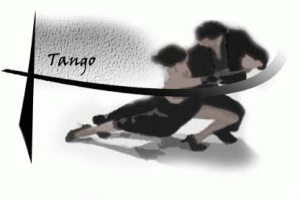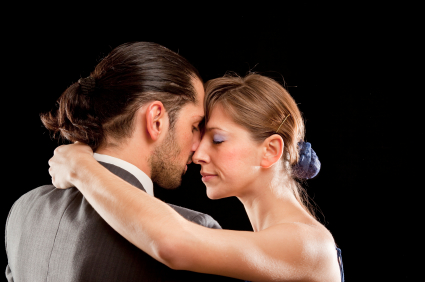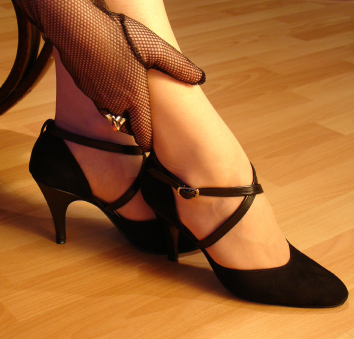The first time I heard of the Tango Hotline, I laughed. The name was so apt. A hotline for the tangueros and milongueras who desperately need to find a “milonga” where they can dance.
 My tango obsession began after I had broken up with a long-time boyfriend. It was May. So I took ballroom dance lessons. At first there was rumba and waltz, mambo and swing and hustle… but a few months later, by the time summer’s heat lay over New York, there was just tango. Argentine tango.
My tango obsession began after I had broken up with a long-time boyfriend. It was May. So I took ballroom dance lessons. At first there was rumba and waltz, mambo and swing and hustle… but a few months later, by the time summer’s heat lay over New York, there was just tango. Argentine tango.
Maybe it was the way the music saturated the evening milongas, or the intensity of following each step. I stepped onto the dance floor and left my usual world. Life was drenched with the sounds of the bandoneon and the violin, bathed in the glow of the tiny lights that lined the mirrored walls. Around me, men and women moved in a sinuous tango walk. A woman swept her extended leg in an arc as she turned; a man rocked his partner as a chord shivered in the air.
No doubt my growing skill on the floor fed the obsession. I spent hours in class. I practiced putting my weight forward, feeling the connection with my partner, extending my leg straight back when I stepped. The dance studio became a second home. People’s faces and dance styles became familiar. When I returned after the dance studio’s vacation week and saw their faces again, I felt like I was seeing old friends.
Then I had my first experience of “tango heaven.” It was late in the evening at the Wednesday milonga—the time when the dancers have thinned out to a small group of the dedicated. Almost everyone else was partnered off, dancing complicated, graceful steps far above my level; but I stayed in my chair, waiting and watching.
“Would you like to dance?” I turned and saw a slender man, older than me, with a thin nose and a friendly expression. I stood up.
As soon as we began to move, I could tell that this dance was different. His lead was smooth and balanced—I knew exactly what he was asking me to do. We moved with invisible harmony. I closed my eyes: everything disappeared except for the music and the perfect connection between us. I turned; I swiveled; I balanced on one leg while he turned me in a circle. I did things I had never done before—things I could not repeat with anyone else. All I had to do was focus on the subtle shifts of weight; if I paid attention to that, and only that, I could do anything. The dances blurred into each other. When I opened my eyes between dances, I could barely recognize the room.
Afterward, I learned that his name was Stephen. We talked for a few minutes, and then we said good night. We didn’t talk about personal things; we didn’t exchange numbers; we didn’t make plans to dance again. We didn’t have to—the moments themselves had been so perfect. That was tango.
Other tango dancers know the feeling. “It’s a ‘child feeling,’” my teacher Virginia Kelly told me. “Rocking in someone else’s arms. It’s a very primary feeling. It’s sensual, but not sexual. Tango brings to the surface a lot of feelings and sensations that we normally repress. …People begin tango thinking, ‘I’ll go to tango class two times a week instead of the gym,’ and they end by getting rid of the furniture so they can dance in the living room.”
This happened to Virginia—she began dabbling as a university art student in Buenos Aires, fitting tango in among her many other activities, but “each time tango became stronger, eclipsing the other activities.” Eventually she moved the furniture (and put in mirrors and a barre), started a tango dance troupe, and began performing in Argentina and abroad.
The furniture phenomenon is not limited to tango professionals; and it is just one of the symptoms—quoted in a web posting called “You know you’re a tango junkie when…”—that I have personally verified by looking at the lives of tango dancers around me.
At milongas, people asked each other, “Do you have any non-tango friends left?”—then laughed as they said no. Once, when talking to Stephen again (months after our first dance), I asked if his girlfriend danced tango. “No, unfortunately not,” he said. He smiled. “But she’s an important part of my life. I can’t just get rid of her.”
 Another evening Jennifer, a fellow tanguera, explained that she planned her dates around tango. Then she hoped the dates would go badly so she could leave early and dance. As soon as I laughed, I recognized the tango junkie in myself. I wasn’t questioning the fact that she planned her dates around tango. No, it was something else. “You can date and tango?” I said incredulously. It was true that Jennifer was one of those very well put-together women (she had the classic, simple Upper East Side beauty that takes at least two hours in front of the mirror every day; and she also had a full-fledged career and a daughter that she raised alone); but still, how could she manage to dance tango and date?
Another evening Jennifer, a fellow tanguera, explained that she planned her dates around tango. Then she hoped the dates would go badly so she could leave early and dance. As soon as I laughed, I recognized the tango junkie in myself. I wasn’t questioning the fact that she planned her dates around tango. No, it was something else. “You can date and tango?” I said incredulously. It was true that Jennifer was one of those very well put-together women (she had the classic, simple Upper East Side beauty that takes at least two hours in front of the mirror every day; and she also had a full-fledged career and a daughter that she raised alone); but still, how could she manage to dance tango and date?
I turned to Dimitrije, the guy I was starting to like. “Would you date someone who didn’t dance tango?” (Meaning: I dance tango. Wouldn’t it be convenient to date me?)
“I would make her learn,” he said. “I would say, ‘You have to learn tango or we can’t go out anymore.’”
I tilted my head. “After how many dates?”
He pretended to think. “After the first one.”
I thought he was interested in me. There was the evening he had asked me for dance after dance. (But maybe he just thought I was a good dancer…) There was the fact that we regularly left milongas together and shared cabs home. (We did live in the same neighborhood…) Also, he invited me to milonga after milonga. (But, he invited other people too: he was part of a group of tango dancers who treated weekends as one long tango marathon. It began with a Friday milonga at La Belle Epoque, then continued on Saturday with afternoon classes, an afternoon practice session, and tango in Central Park. After dark, they went to Lafayette Grill for another milonga, followed by Danel & Maria’s milonga until the early hours of the morning. On Sunday they took more classes and ended the weekend with a milonga at DanceSport. They didn’t stop for meals: they ate yogurt during tango classes and grabbed hot dogs on their way to the park. Given all this, it was hard to tell what Dimitrije’s invitations meant. Maybe he was just an experienced junkie taking a newbie under his wing.) I also questioned the wisdom of dating another tango dancer—it would be like dating someone from work. While I deliberated, I went with the flow, which meant going to milongas.
Still, there were limits to my participation. I couldn’t manage the complete tango marathon because I was facing a distinctly negative side of tango obsession: foot pain. I (a woman who believes that high heels are the contemporary Western equivalent of ancient Chinese foot binding, and who will only wear shoes in which I can run and kick people) had already succumbed to buying dance shoes with a 1-1/2″ heel after my initial five-day-a-week ballroom dance schedule made me realize that dance shoes were not a materialistic vanity but an absolute health necessity. I thought I had taken care of foot health, but shortly after the tango obsession took hold, the balls of my feet began to hurt. I continued to dance tango, of course. I simply looked for other ways to deal with my dilemma. Numerous trips to the web convinced me that my problem was not unique. (Tango-L discussion group thread: Pain on the balls of the feet.) Podiatric web sites blamed high heels (90 percent of foot operations were done on women, and most of those could be attributed to high heels, said one). I consulted with other dancers.
ME: So, I’ve been having pain on the balls of my feet—I think because we’re supposed to put our weight forward so much—and I wondered if you had any…
ALEJANDRA, a tango teacher: Yes, my feet hurt every day.
ME: Isn’t there anything I can do about it?
ALEJANDRA: I just live with it.
 I looked at the casual shoes she was wearing (brightly colored sandals with three-inch heels) and decided that her approach would not be mine. Dimitrije suggested leather-soled shoes (suede-soled ballroom shoes were too thin) and showed me the blue athletic inserts he wore in his shoes. I began to frequent the Dr. Scholl’s displays in my local drugstore. At the same time, I was, very logically, looking for tango shoes despite the fact that this involved an “upgrade” to 2-1/2″ or 3-1/2″ heels. (I told myself I needed them for the leather soles.) My search for shoes led me, among other places, to Dee. Dee had been dancing for many years, and she was a strong advocate for her shoes.
I looked at the casual shoes she was wearing (brightly colored sandals with three-inch heels) and decided that her approach would not be mine. Dimitrije suggested leather-soled shoes (suede-soled ballroom shoes were too thin) and showed me the blue athletic inserts he wore in his shoes. I began to frequent the Dr. Scholl’s displays in my local drugstore. At the same time, I was, very logically, looking for tango shoes despite the fact that this involved an “upgrade” to 2-1/2″ or 3-1/2″ heels. (I told myself I needed them for the leather soles.) My search for shoes led me, among other places, to Dee. Dee had been dancing for many years, and she was a strong advocate for her shoes.
DEE: They’re like cancan boots, very tight, with pointed toes. Very sexy. A lot of dancers in New York are wearing them.
(One of the podiatric web sites had said high heels and pointed toes were a particularly bad combination.)
ME: Yeah?
DEE: Oh, yes. They’re very good for building your balance, which is very important for tango, you know. I just had a foot operation, and after only a year and a half of wearing my shoes, my balance is almost completely back to normal.
(A foot operation? I wasn’t getting her shoes!)
(Still, didn’t tango mean I had to wear heels? A small part of me was beginning to accept the sad truth that I too would have to get a foot operation some day.)
DEE: I can bring you samples if you like. What size do you wear? Where are you dancing tonight? I’m at Dance Manhattan today and Triangulo tomorrow…
We tried to negotiate a meeting place, but I (a very moderate tango junkie, it seemed) only went to two milongas a week—both at my uptown dance studio—while she, apparently, danced every night—but never above Chelsea. Feminism and foot pain finally winning out over the seduction of shapely tango-shoe silhouettes, I eventually settled for a pair of two-inch heels in which I could wear padded orthotics.
Dimitrije was paying for my cab rides home. Feeling guilty, I offered to take him out for dinner. He liked the idea, and we arranged to meet on the one night we weren’t dancing. During the dinner, we were nervous and happy, telling stories of childhood mishaps and college adventures. After dinner, walking through the Soho streets, he slid his arm around me. I let it rest there. Then, as we walked, I slipped my arm around his back and pulled back gently. He noticed, and when I put a tango syncopation into my steps, he matched it. When I stopped, he stopped. I applied an upward pressure as he had so many times with me—and to my delight, he lifted his foot.
Our tango obsession reached its height in September. Dimitrije and I signed up for a month of classes at a studio known for its good tango program—and its extensive course offerings. “Tango boot camp,” we called it. We had spent a lot of time in tango classes at our old studio, but we discovered that we had been dilettantes—three-day-a-week, nine-class-a-week pretenders. Here, Monday to Friday, for several hours each day, we worked on sacadas, boleos, enrosques. He practiced following; I learned to lead. We struggled through a couples-only advanced course. We learned about posture, posture, posture. On our second Friday evening, tired from our three classes, we trudged to La Belle Epoque, the French-Creole restaurant which had become our regular Friday night date. Sitting over my mango chutney salmon, I looked at him. We had already been lingering over dinner for an hour.
“Do you want to dance?” I said.
He looked over the balcony railing at the dancers below. “Maybe later. Do you?”
We smiled at each other. We had been seeing each other almost nightly for weeks, but we had yet to see a movie together or go to a friend’s party or even dance most of the non-tango dances.
“Not so much,” I said. “Maybe next Friday we could see a movie.”
Copyright 2001 by Emmeline Chang






